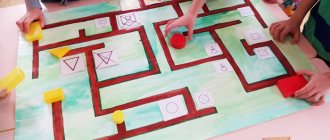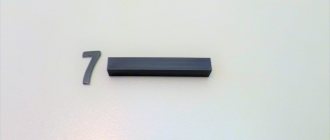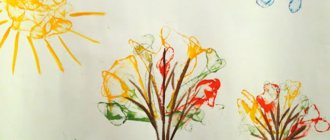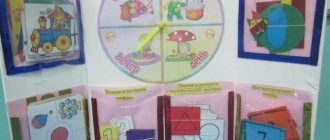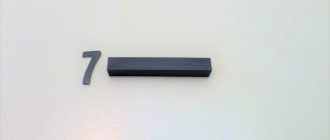Excerpts from one of the parent forums:
“Does anyone have these blocks? Do children like it or do they use it for the most - building houses? I'm wondering whether to order such a box or not? Will they just scatter it all over the apartment again?”...
*
“In my opinion, it’s not necessary. These blocks are good to use in classes in kindergartens, otherwise there is little interesting in them, geometric figures and that’s all.”
Well what can I say? You can scatter anything...
Dienesha blocks for preschool children
Dienesh blocks look like three-dimensional geometric objects, reminiscent of those from which children usually build houses. However, this is not just a construction set, but material for a whole series of educational and educational games.
The set includes 48 non-repeating shapes. Each object differs from the others in at least one of 4 parameters:
- geometry - circle, square, triangle, rectangle;
- color – red, blue, yellow;
- size – large, small;
- volume - thick, thin.
That is, the set consists of 4 groups of figures of 12 pieces each. Groups of Dienesh blocks allow you to organize many exciting games that teach preschoolers to analyze, compare, generalize, and classify information. The set is supplemented with cards with illustrative, schematic and template images, as well as descriptions of tasks.
Ready-made cards and assignments are in demand; with their help, it is easier for a preschooler to get acquainted with geometric shapes. Based on the schematic image, the child makes a picture. Younger children place blocks directly on the diagram. Older preschoolers lay out the figures next to the schematic image.
The method was invented by educational psychologist Zoltan Dienes. It is an entertaining game form for developing mathematical thinking in children. According to the famous teacher, mastering mathematics is only effective when the child does not get bored. It is difficult for a preschooler to fix information in his mind when he has to listen for a long time and strain his brain. And the game method allows the child to absorb and remember information without stress and fatigue.
The method of teacher Dienesh develops mathematical thinking. For the comprehensive development of a child, it is necessary to use other teaching methods.
Dienesh's method involves 6 learning stages, depending on the age abilities of the children:
- a game without rules - the child learns to work with blocks, he develops mathematical concepts;
- playing by the rules;
- lesson with comparative analysis;
- representation – the child plays in accordance with the proposed methods, focusing on the acquired knowledge;
- creative activities conducted in accordance with logical concepts;
- formalization is that level of classes at which a preschooler is already able to draw conclusions and justifications.
History of creation
It is interesting to look at some facts from the biography of the Hungarian teacher, mathematician and child psychology researcher Zoltán Dienes. It was he who gave children of all countries a wonderful way to develop and comprehend the mathematical side of reality. He really wanted to create something that would make mastering exact mathematical science comfortable, interesting and entertaining. As a result, he achieved his goal and developed an excellent technique, which is very popular among teachers and parents.
The learning process should not be boring, Zoltan Dienes believed
When something is explained to a child for a long time, he needs to listen carefully, then try to repeat what he heard, then he, as a rule, loses interest and cannot maintain stable attention for a long time
While examining the peculiarities of the development of mental abilities in preschool children, Dienesh made an important conclusion: children cope well with mastering numbers and simple arithmetic, but they are extremely weak in understanding abstractions. The child searches for an answer, often using a pattern (scheme) already known to him.
But the search is not always successful. Based on this fact, Dienes came up with a way to familiarize yourself with complex abstract categories in an accessible visual form. This approach is an important component of preparing a child for further education at school. But on top of everything else, it brings kids a lot of fun in the process of mastering logic.
Goals and objectives
Young children have no problem mastering arithmetic, but they struggle with abstract thinking. When searching for information, a child tends to rely on patterns, but this does not always work out. Dienesh invented a technique through which preschoolers learn about abstract concepts by visualizing them. Dienesh's math blocks are an easy-to-understand and fun way to prepare for school.
The purpose of Dienesh's games is to develop logical and mathematical thinking among kindergarteners and primary schoolchildren.
Tasks:
- training in the skill of analyzing forms, comparing them according to certain parameters;
- creative and intellectual development;
- developing the ability to think logically, build chains of thoughts, and make assumptions;
- formation of responsibility, perseverance, diligence;
- speech development, expansion of individual vocabulary.
The use of Dienesh blocks is relevant in kindergartens and grades 1-2 of primary school. That is, classes are intended for children 2-8 years old.
How to play with LBD?
There is a small manual in the box with the blocks, which is very schematic. You can get acquainted with logical blocks in detail using the books: “Let's Play” (edited by A.A. Stolyar. - M., 1991, 1996), as well as “Logic and Mathematics for Preschoolers” (edited by Z.A. Mikhailova - St. Petersburg, 1996, 2000).
I will share my own experience of working with children as a methodologist - practice manager and home teacher.
All games and game exercises can be divided into 4 groups with gradual complication:
- to develop the skills to identify and abstract properties;
- to develop the ability to compare objects according to their properties;
- for the development of classification and generalization actions;
- to develop the ability to perform logical actions and operations.
All games and exercises, with the exception of the fourth group (logical), are not addressed to a specific age. After all, children of the same calendar age can have different psychological ages. Some of them reach the next stage in intellectual development a little, and some much earlier than other peers, but everyone must go through all these steps. If the child cannot cope with the task on his own, then it is necessary to simplify the task, and so on until the child solves the problem. An independent and successful decision will be the step from which you should start moving forward.
If you keep children at a certain level or give them more complex games and exercises prematurely, then interest in activities will disappear. Children are drawn to mental tasks when they are difficult for them, but doable.
It is good for an adult to become an equal partner during games. He didn’t edify, he played! Before starting games and exercises, let the child independently use them at his own discretion in games. As a rule, children are happy to build something out of them. During such games with blocks, the baby will establish that they have different shapes, colors, sizes and thicknesses. When communicating with a child, it is better to use the word “figure” than the word “block”.
Junior group
For children of a younger age group, primitive games are suitable, in which you need to group and separate objects according to parameters.
Find the same one
The teacher shows the figure. The player must find the same object based on one parameter: geometry or color. For example: a yellow triangle is shown. This means you need to find either red and blue triangles, or other yellow shapes.
Find something different
The opposite of the previous task. It is required to find figures that differ from the demonstrated element in a certain parameter: size, color, geometry.
Plant in the beds
For the game you need to prepare improvised beds. The blocks will be vegetable seeds. The teacher gives the task to plant the seeds in certain beds. For example, for the first bed - small and red, for the second - square and yellow.
Feed the toys
To play, you need to place dolls or soft toys on the table. Dienesh blocks will be food. The teacher explains that toys want to eat, but each of them has its own food. For example, a teddy bear eats large yellow figures, and the Masha doll eats small blue ones. The players’ task is to choose the right blocks for each toy.
Middle group
Middle age preschoolers can play with diagrams and pictures. It is advisable to choose creative games with Dienesh blocks so that students use their imagination as much as possible.
Game with pictures
To play, you need to buy or print color pictures depicting different objects in a geometric representation. The child’s task is to correctly place the blocks on the picture. For example, the car wheel shown is a circle. This means you need to apply a round block.
Build a row
The game greatly develops the ability to analyze.
You need to place several blocks so that a clear sequence is formed. The player must understand which piece to place next. For example, a red circle followed by a blue one. Therefore, the third one will be the yellow circle. Or this combination: circle, square, triangle - all red. This means that the fourth figure will be a red rectangle.
What's extra
The game teaches you to group objects according to certain characteristics.
The teacher lays out 3 or 4 figures in front of the child. One should be superfluous, that is, not having a single common feature with the others. The player must point to the wrong object and explain his decision.
When the child begins to cope with it with ease, complicate the task: put 6 figures, of which two should be incorrect.
Point to an object with "not"
The teacher lays out the blocks and names signs with negation. And children must point to the corresponding objects. For example, “this figure is not red” or “this is not a triangle.”
Fix the bridge
To play, you need to prepare cards depicting geometric shapes, indicating their colors and sizes. And also similar cards, but with crossed out images, meaning that the block should not have such signs.
The teacher tells a story about how a bridge broke between the houses of two fairy-tale characters, and the neighbors can no longer see each other. The students' task is to repair the bridge. Only the “bricks” need to be laid not at random, but according to a certain rule, then the structure will be strong and will no longer break.
Next, the teacher shows 1-2 cards with parameters, and the children choose the appropriate “bricks”. For example, cards are shown with a crossed out triangle and an uncrossed red color. This means that the next “brick” for the bridge must be red, but cannot be a triangle.
Which figure disappeared
The game strengthens memory and concentration.
The teacher lays out several blocks in a row. The child tries to remember the sequence, then closes his eyes. The teacher removes one element of the sequence. The pupil, having opened his eyes, must remember what figure was in the place where it is now empty.
The game can be a little more complicated: do not leave an empty space, but replace the removed block with another. Then the player’s task becomes to return a number of figures to their original form. If the child copes well, you can complicate it even more: replace not one, but 2-3 objects.
Constructor
Children love to play with Dienesh blocks as if they were construction sets. This game develops imagination and creative thinking.
Children construct something at the suggestion of the teacher or at their own request. To begin, have students practice constructing using a visual diagram. Then they must use their imagination.
Field for imagination
In order not to get bored - after all, any thing gets a little boring - you can add absolutely any scenarios.
For example, build baskets and put wooden fruits in them - that's what you have, or real fruits, and then have fun crunching them. You can take various interesting animals and build different ships for them. And these animals will travel with us. Don't be afraid to create, don't be afraid to experiment.
If your cubes are not wooden, then you should try to compensate for this with different materials. The materials are all different in texture: very noisy, ringing plastic; and a wonderful tree; and everyone’s favorite glass – heavy, smooth, noisy; and wonderful bright multi-colored buttons.
This is the universality of the aids - the principle that you can use whatever is at hand to play. Moreover, if you do not have the opportunity to buy a manual, you can open a page on the Internet and see the entire list of materials.
You can, if you don’t have wood, glue them together from cardboard and create this educational set for your child, so universal that you can go with it into a long life as a researcher of physical phenomena and a young conqueror of interesting mathematical tasks.
Senior group
Dienesh's logic blocks help kindergarteners preparing for school to improve their math skills. Children learn to count, compare, and contrast.
House
To play, draw a diagram of a house. In every room there lives a geometric figure, you need to draw it there. Certain blocks should not live in some rooms; crossed out figures should be drawn there. The pupils’ task is to correctly distribute the blocks among the rooms.
Shop
Make a makeshift store for the game. Let the goods be toys, treats, and stationery. And money is Dienesh’s blocks.
The teacher distributes blocks to the children. Then he says which product costs how much. For example, for a teddy bear you need to pay two triangles. A child, looking at his “money,” understands whether he can afford to buy this product.
Price requirements should gradually become more complex. First, the colors of the blocks are added to the price, then the sizes. For example, “for a doll you need to pay a blue rectangle” or “a box of pencils costs two large circles of yellow and red colors.”
Domino
Blocks are distributed equally between players. The first participant, chosen by lot, places a piece on the table. The next player must place a block that matches the first one in one of the indicators: color, shape or size. If there is no such block, you will have to skip a move. The winner is the player who gets rid of all his pieces first.
Christmas tree
The game develops the skill of counting in order and navigating through schematic images. For this lesson you need to prepare a picture of a Christmas tree and 15 character cards. Dienesh blocks will be Christmas balls.
To decorate the spruce, 15 balls are used: 5 rows of 3 pieces. On the cards, numbers indicate row numbers, and one of the 3 circles filled in indicates the location of the ball in the row. At the bottom of the picture it is indicated which geometric figure will represent a particular Christmas ball.
Find the treasure
The teacher places blocks in front of the player. The child turns away so that the teacher can hide a coin under one of the laid out objects. To find the treasure, the player asks questions. For example: “Treasure under the red block?” The presenter answers: “No.” This means that red objects are excluded; there is no coin under them. Next: “Treasure under the round block?” Host: “Yes.” This means you need to look among the round shapes. And so on until the treasure is found. Having found the treasure, the player himself becomes the leader, hiding the coin for another participant.
Gifts for animals
To play, you need to place three hula hoops on the floor so that they intersect. Next to each circle, plant a soft toy, for example, a bunny, a bear, or a fox.
The teacher explains to the students that the animals quarreled over the gifts and cannot share them. The bunny wants small ones, the fox wants triangular ones, and the bear cub wants fat ones. Only some gifts are small, triangular, and thick. Because of them, the animals argue. The children’s task is to distribute the blocks so that the controversial ones lie at the intersections of the hula hoops.
Journey
For an exciting game, you need to prepare the playing field: there is one start, then the path branches into many paths. At the beginning of each path there should be a road sign indicating which block can follow it. If the block is prohibited from passing, it will have to take another path.
For example, at first the road splits in two: large blocks go along the left branch, small blocks go along the right. Next comes the branching by color. It is advisable that at the end of each path some interesting place is drawn - the final goal of the trip: a school, a cafe, a beach, a store, a pharmacy.
